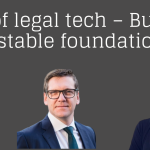UK top 20 law firm Clyde & Co is in the process of rolling out Lexis Everyfile, LexisNexis’s web-based matter management application that was made generally available in October last year. Clyde & Co has been collaborating with LexisNexis on developing the product for around two years.
The international firm, which has a large presence in the insurance market, has used LexisNexis’ case management system Visualfiles for years across various practice areas, including volume insurance claims handling. It is consolidating multiple case management systems into Visualfiles following its merger with BLM and anticipates that Everyfile, which is part of Lexis’ Omni platform, will be rolled out across its UK insurance practice this year. The firm is running pilots of Everyfile for more complex matters that have traditionally been resistant to case management.
Speaking to Legal IT Insider, Clyde & Co’s head of legal delivery and innovation, Nick Roberts, said: “We have been using Visualfiles because there’s quite a strong requirement to collect data and report on MI, plus there’s quite a lot of processing and you need people to do the same thing, the same way, each time.
“What we have started to see though is those requirements for data and MI and turnaround times starting to creep into bigger value, more complicated claims where there is a need to gather a certain level of data; understand where everything is up to; and where you have a complicated procedural timeline that you have to follow and monitor.”
While Roberts says that more complex work can’t be expected to have consistent turnaround times or templates in the way that higher volume work does, what was required was a more flexible matter management system to monitor developments in MI terms, while giving fee earners flexibility in how they are using it.
Roberts told Legal IT Insider: “What was needed was something all in one place that connects to our document management system. Visualfiles works very well for what it does, but if you’re using a system that doesn’t really work for the type of work that you’re doing, or you’re using a data capture tool and you’re constantly having to move between different systems all day, it becomes painful and inefficient.”
Having collaborated extensively with LexisNexis on developing Everyfile, Clyde & Co is rolling it out to teams that work outside it mainstream volume insurance business as well as looking at how to use Everyfile to capture data for more complex work in the likes of litigation and arbitration, where clients don’t have the same MI requirements but would benefit from the capture of more data.
Roberts says: “What’s different here is the collaboration with LexisNexis. Typically, we find a piece of software and we take what the software does and it and it either works for us or it doesn’t. One of the things we always wanted to do on this is to be able to involve our partners and fee earners and route their feedback through our head of knowledge for the firm, because it’s in their interest that we produce something that has the right functionality and that is going to make a difference.
“We are very much on a new journey from commoditised work to this sort of hybrid, where there’s a lot of requirements around turnaround times in MI, and that’s where we’ve got Everyfile deployed and building that up today. Our next journey is taking that into these really complex teams and moving away from a calendar-led LPM approach, to a way we can capture the data in the system, which is really exciting.”
Clyde & Co users open either the Visualfiles viewer or Everyfile viewer depending on the matter type. LexisNexis Enterprise Solutions general manager Andrew Lindsay said: “The concept of the Omni platform is that the data is all stored in the same place. So, it’s centralised, you’ve got one digital file that you can use across your entire organisation or your data feeds back into the one database, rather than having it in pockets everywhere.”
At the user level it has proved difficult in the past to create a flexible no-code task management interface for complex matters. Lindsay says: “Conceptually we have this idea of a foundation framework for everybody in the organisation. So you have the base level system that may just been file opening, capture data, file close, so if there’s a lawyer that doesn’t want to use the system, that’s what you do. While it’s base level, it does 5% functionality.
“On top of that, then you’re able to extend it out depending on the departmental needs of everybody as to what the system does. In a Visualfiles world, that’s quite a heavy lifting project because it’s going to be very procedural. Your debt department’s going to want to do something different to your climate department, to your wills and probate department.
“In the Everyfile world, we have a low code concept that once you’ve established your base level across the business, then different departments can change and tweak and elaborate their version of it to give them what they want. So you could have people in one department using 5% functionality, another department using 15%, another department using 75%, it’s down to them. You’re appealing to lawyers, you’re not pushing software on them and saying, ‘You must use this in this particular way.’ You’re saying, ‘We have the capability, what do you want it to do? And it should be very easy to to change and tweak, that’s where we want it to go.”
Asked if that is the case in practice, Roberts say: “In Everyfile you get a base layer but the rest of it is the way you want to manage the tasks, set up tasks and move the tasks, and the way you want manage the calendars. We have put in a template of tasks so that you could collapse, expand, hide or move them around. You’re giving people a base without telling them they have to use it. It’s about putting it all in and helping them play with it.”
Roberts has been working with ‘legal designer’ lawyers who form a bridge between the IT team and end users to help them develop the functionality and he says: “You need someone who can understand what a lawyer’s day looks like, but they also understand the IT side, and they sit there and say, ‘That doesn’t work the way you’re doing it.’”
Engagement has been high, and Roberts says: “We have individuals in our complex teams who have chargeable hours targets to hit and yet they are giving up their time to spend and engage in helping to build and develop and and get it rolled out because they really do see the value.”









